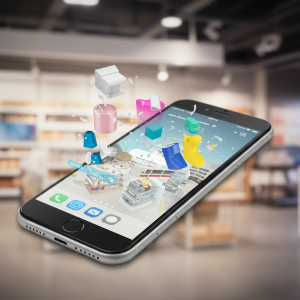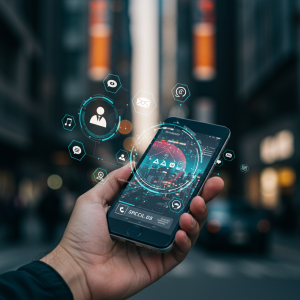Augmented Reality Mobile Marketing: A Comprehensive Guide to Boost Engagement in 2025

What Is Augmented Reality in Mobile Marketing?

Augmented reality integrates computer-generated sensory inputs—such as images, videos, and 3D models—into a user’s real-world environment. Unlike virtual reality, which creates a wholly artificial setting, AR enhances reality by adding layers of interactive digital objects. On mobile devices, this can range from face filters in social apps to furniture previews in home-decoration services. Learn more about The Top Benefits of Mobile Marketing.
Key Benefits of AR for Mobile Campaigns
- Enhanced Engagement: Interactive AR features capture attention and encourage users to spend more time with your app or campaign.
- Stronger Brand Recall: Memorable AR experiences are more likely to be shared on social media, boosting organic reach.
- Personalized Experiences: AR can leverage location data and user preferences to deliver tailored content in real time.
- Higher Conversion Rates: Shoppable AR—where users can tap on virtual products to purchase—reduces friction in the buyer’s journey.
- Data-Driven Insights: Interaction metrics (time spent, objects tapped, share rates) provide actionable insights for campaign optimization.
Real-World AR Marketing Case Studies
1. IKEA Place
IKEA’s AR app lets users place virtual furniture in their own living spaces before buying. By visualizing scale, color, and style, customers gain confidence to purchase big-ticket items online. Conversion rates rose by over 30% among users who engaged with the AR feature.
2. Sephora Virtual Artist
Sephora’s mobile app includes a virtual try-on tool powered by AR. Customers can test makeup shades on their own selfies, which led to a 150% increase in product page visits and a 20% boost in add-to-cart actions.
3. Pepsi Max “Unbelievable” Bus Shelter
In London, Pepsi Max transformed a bus shelter glass into an AR window showing UFOs and tigers roaming the street. The viral campaign generated millions of views online, demonstrating AR’s potential for brand virality.
Step-by-Step Implementation Guide
- Define Your Objectives: Clarify what you aim to achieve—brand awareness, lead generation, or direct sales. Align AR features with these goals.
- Choose the Right AR Platform: Consider AR SDKs like Apple ARKit, Google ARCore, or cross-platform tools such as Vuforia or ZapWorks. Evaluate based on supported features and device compatibility.
- Design User Stories: Map out scenarios in which users will interact with the AR experience. Create wireframes that integrate AR seamlessly into your mobile UI/UX.
- Develop 3D Assets: Work with 3D artists to produce optimized models (low-poly where possible), textures, and animations. Ensure file sizes remain mobile-friendly.
- Integrate and Test: Embed AR components into your mobile app or web AR pages. Conduct extensive testing across devices, lighting conditions, and network speeds.
- Launch and Promote: Roll out your campaign via app stores, push notifications, email marketing, and social media teasers. Encourage user-generated AR content with dedicated hashtags.
- Monitor and Iterate: Track KPIs such as session length, interactions per session, and share rates. Use A/B testing to refine visual elements and calls to action.
Best Practices for AR Mobile Marketing
- Keep It Intuitive: Provide clear on-screen prompts and minimal learning curves. Users should understand how to activate and interact with AR immediately.
- Optimize Performance: Compress 3D assets, limit real-time rendering complexity, and preload essential data to prevent lag.
- Ensure Accessibility: Consider color contrasts, font sizes, and alternative content for users with disabilities.
- Promote Sharing: Include social-share buttons directly within the AR interface. Incentivize sharing with discounts or contest entries.
- Maintain Privacy Compliance: Disclose any data collection (camera, location) and adhere to GDPR, CCPA, or other regional regulations.
Measuring AR Campaign Success

Traditional metrics like impressions and click-through rates remain relevant, but AR introduces new engagement measures:
- Activation Rate: Percentage of users who launch the AR feature after viewing the prompt.
- Interaction Depth: Average number of AR elements interacted with per session.
- Time Spent: Duration of each AR session, indicating user immersion.
- Social Shares: Volume and reach of user-generated AR content shared on social platforms.
- Conversion Lift: Comparison of conversion rates between AR users and non-AR users.
AR Mobile Marketing Trends for 2025
- Web-Based AR: Advancements in WebXR enable AR experiences without requiring app downloads, lowering adoption barriers.
- AI-Driven Personalization: Machine learning tailors AR content in real time, delivering product recommendations based on user behavior.
- Social Commerce Integration: Platforms like Instagram and Snapchat are embedding AR shopping features directly in their feeds.
- Gesture and Voice Controls: Future AR interactions will leverage natural gestures and voice commands to enhance usability.
- Mixed Reality Collaboration: Brands will experiment with collaborative AR workspaces, allowing multiple users to share and modify virtual objects simultaneously.
Conclusion
Augmented reality is no longer a novelty—it’s a strategic imperative for mobile marketers aiming to stand out in a crowded landscape. By delivering immersive, interactive experiences, AR drives deeper engagement, higher conversions, and stronger brand loyalty. As you plan your 2024 campaigns, prioritize seamless integration, performance optimization, and data-driven iteration to unlock the full potential of AR. The future of mobile marketing is here—and it’s augmented.





